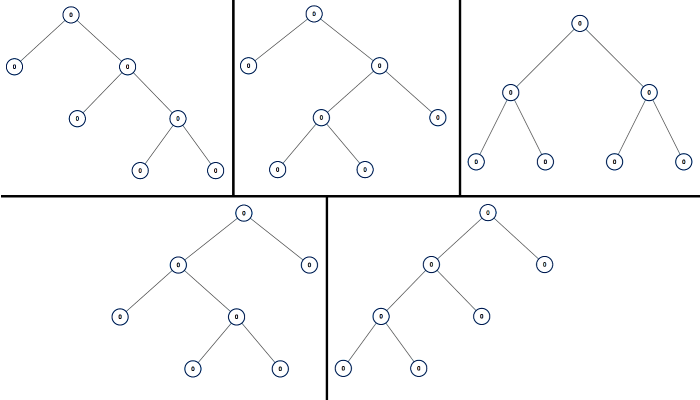★★★★★★★★★★★★★★★★★★★★★★★★★★★★★★★★★★★★★★★★
➤微信公众号:山青咏芝(shanqingyongzhi)
➤博客园地址:山青咏芝(https://www.cnblogs.com/strengthen/)
➤GitHub地址:https://github.com/strengthen/LeetCode
➤原文地址: https://www.cnblogs.com/strengthen/p/10605621.html
➤如果链接不是山青咏芝的博客园地址,则可能是爬取作者的文章。
➤原文已修改更新!强烈建议点击原文地址阅读!支持作者!支持原创!
★★★★★★★★★★★★★★★★★★★★★★★★★★★★★★★★★★★★★★★★
A full binary tree is a binary tree where each node has exactly 0 or 2 children.
Return a list of all possible full binary trees with N nodes. Each element of the answer is the root node of one possible tree.
Each node of each tree in the answer must have node.val = 0.
You may return the final list of trees in any order.
Example 1:
Input: 7
Output: [[0,0,0,null,null,0,0,null,null,0,0],[0,0,0,null,null,0,0,0,0],[0,0,0,0,0,0,0],[0,0,0,0,0,null,null,null,null,0,0],[0,0,0,0,0,null,null,0,0]]
Explanation:

Note:
1 <= N <= 20
满二叉树是一类二叉树,其中每个结点恰好有 0 或 2 个子结点。
返回包含 N 个结点的所有可能满二叉树的列表。 答案的每个元素都是一个可能树的根结点。
答案中每个树的每个结点都必须有 node.val=0。
你可以按任何顺序返回树的最终列表。
示例:
输入:7 输出:[[0,0,0,null,null,0,0,null,null,0,0],[0,0,0,null,null,0,0,0,0],[0,0,0,0,0,0,0],[0,0,0,0,0,null,null,null,null,0,0],[0,0,0,0,0,null,null,0,0]] 解释:

提示:
1 <= N <= 20
116ms
1 /** 2 * Definition for a binary tree node. 3 * public class TreeNode { 4 * public var val: Int 5 * public var left: TreeNode? 6 * public var right: TreeNode? 7 * public init(_ val: Int) { 8 * self.val = val 9 * self.left = nil 10 * self.right = nil 11 * } 12 * } 13 */ 14 class Solution { 15 var countToTrees: [Int: [TreeNode]] = [ 16 1: [TreeNode(0)] 17 ] 18 19 func allPossibleFBT(_ N: Int) -> [TreeNode?] { 20 if N % 2 == 0 || N < 0 { 21 return [] 22 } else if let trees = countToTrees[N] { 23 return trees 24 } 25 26 var fbts = [TreeNode]() 27 28 let remaining = N - 1 29 var leftCount = 1 30 while leftCount < N - 1 { 31 let leftFbts = allPossibleFBT(leftCount) 32 let rightFbts = allPossibleFBT(remaining - leftCount) 33 34 for lfbt in leftFbts { 35 for rfbt in rightFbts { 36 let root = TreeNode(0) 37 root.left = lfbt 38 root.right = rfbt 39 fbts.append(root) 40 } 41 } 42 43 leftCount += 2 44 } 45 46 countToTrees[N] = fbts 47 return fbts 48 } 49 }
120ms
1 /** 2 * Definition for a binary tree node. 3 * public class TreeNode { 4 * public var val: Int 5 * public var left: TreeNode? 6 * public var right: TreeNode? 7 * public init(_ val: Int) { 8 * self.val = val 9 * self.left = nil 10 * self.right = nil 11 * } 12 * } 13 */ 14 class Solution { 15 var dict: Dictionary<Int,[TreeNode]> = [:] 16 func allPossibleFBT(_ N: Int) -> [TreeNode?] { 17 if N % 2 == 0 { 18 return [] 19 } 20 21 return expand(N - 1) 22 } 23 24 private func expand(_ N: Int) -> [TreeNode] { 25 var result: [TreeNode] = [] 26 if N == 0 { 27 return [TreeNode(0)] 28 } else if N == 2 { 29 let newNode = TreeNode(0) 30 newNode.left = TreeNode(0) 31 newNode.right = TreeNode(0) 32 result.append(newNode) 33 return result 34 } else { 35 if let nodes = dict[N] { 36 return nodes 37 } 38 for i in 0...(N - 2)/2 { 39 let left = i * 2 40 let right = (N - 2) - left 41 let leftNodes = expand(left) 42 let rightNodes = expand(right) 43 for lNode in expand(left) { 44 for rNode in expand(right) { 45 let newNode = expand(2)[0] 46 newNode.left = lNode 47 newNode.right = rNode 48 result.append(newNode) 49 } 50 } 51 } 52 dict[N] = result 53 return result 54 } 55 } 56 }
136ms
1 /** 2 * Definition for a binary tree node. 3 * public class TreeNode { 4 * public var val: Int 5 * public var left: TreeNode? 6 * public var right: TreeNode? 7 * public init(_ val: Int) { 8 * self.val = val 9 * self.left = nil 10 * self.right = nil 11 * } 12 * } 13 */ 14 class Solution { 15 func allPossibleFBT(_ N: Int) -> [TreeNode?] { 16 if N == 1 { 17 return [TreeNode(0)] 18 } else if N < 1 || N % 2 == 0 { 19 return [] 20 } 21 22 var arr: [TreeNode] = [] 23 for i in stride(from: 1, to: N-1, by: 2) { 24 let lArr = allPossibleFBT(i) 25 let rArr = allPossibleFBT(N-i-1) 26 27 for j in 0..<lArr.count { 28 for k in 0..<rArr.count { 29 let t = TreeNode(0) 30 t.left = lArr[j] 31 t.right = rArr[k] 32 arr.append(t) 33 } 34 } 35 } 36 return arr 37 } 38 }
1 /** 2 * Definition for a binary tree node. 3 * public class TreeNode { 4 * public var val: Int 5 * public var left: TreeNode? 6 * public var right: TreeNode? 7 * public init(_ val: Int) { 8 * self.val = val 9 * self.left = nil 10 * self.right = nil 11 * } 12 * } 13 */ 14 class Solution { 15 var cache:[Int:[TreeNode?]] = [Int:[TreeNode?]]() 16 func allPossibleFBT(_ N: Int) -> [TreeNode?] { 17 var N = N 18 var res:[TreeNode?] = [TreeNode?]() 19 if N % 2==0 {return res} 20 if cache[N] != nil {return []} 21 if N == 1 22 { 23 res.append(TreeNode(0)) 24 return res 25 } 26 N -= 1 27 for i in stride(from:1,to:N,by:2) 28 { 29 var left:[TreeNode?] = allPossibleFBT(i) 30 var right:[TreeNode?] = allPossibleFBT(N - i) 31 for nl in left 32 { 33 for nr in right 34 { 35 var cur:TreeNode? = TreeNode(0) 36 cur?.left = nl 37 cur?.right = nr 38 res.append(cur) 39 } 40 } 41 } 42 cache[N] = res 43 return res 44 } 45 }